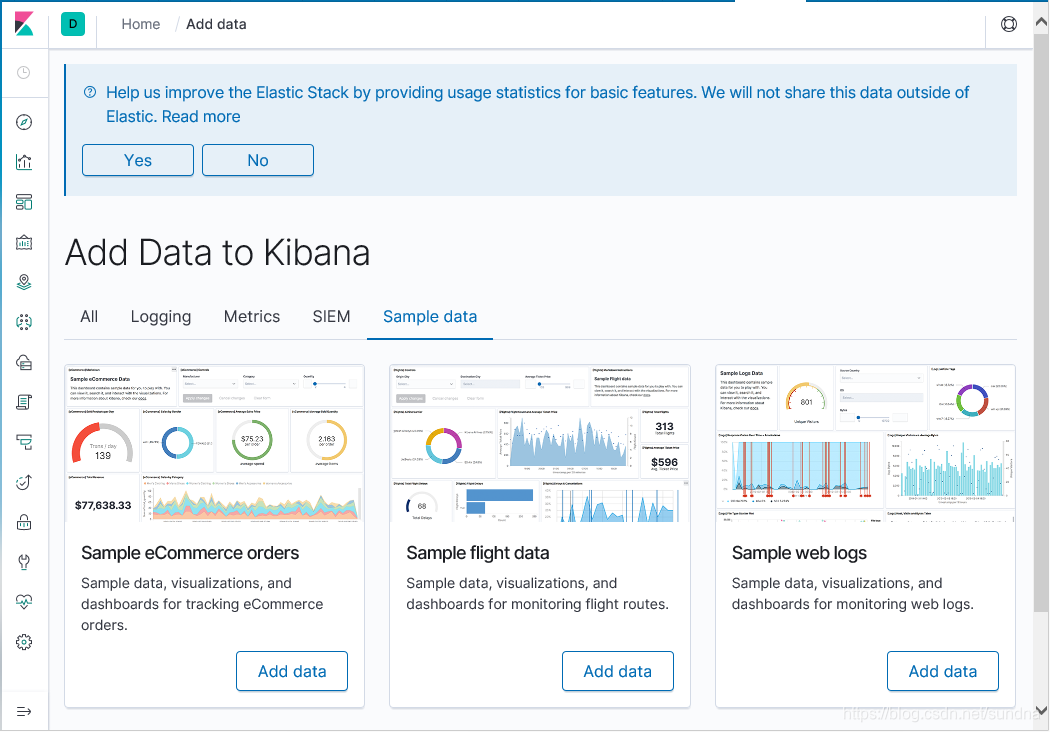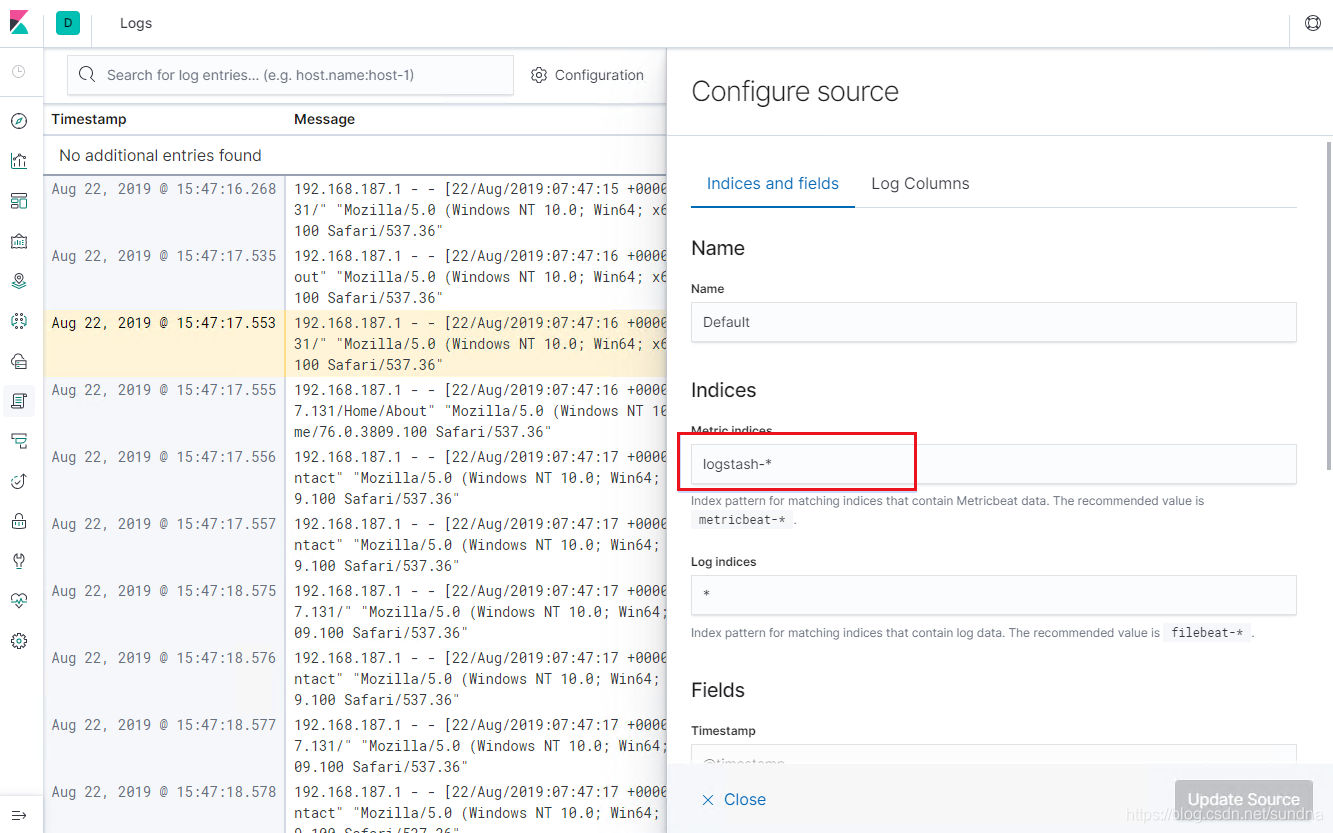环境:
Centos: 7.5
Elasticsearch: 7.3
Kibana: 7.3
Logstash: 7.3
1. 准备
Linux 下安装 Elasticsearch 要使用非 root 账号,得新建一个。
adduser esuser //新建用户
passwd esuser123 //给用户设置密码给用户加 root 权限
修改 /etc/sudoers 文件,找到下面一行,把前面的注释(#)去掉
## Allows people in group wheel to run all commands
%wheel ALL=(ALL) ALL然后修改用户,使其属于root组(wheel),命令如下:
usermod -g root esuser
2. 安装 elasticsearch-7.3.0
Linux 下安装方式,虚拟机里面 curl 下载慢的话可以用迅雷下载再上传文件。
curl -L -O https://artifacts.elastic.co/downloads/elasticsearch/elasticsearch-7.3.0-linux-x86_64.tar.gz
tar -xzvf elasticsearch-7.3.0-linux-x86_64.tar.gz
cd elasticsearch-7.3.0
./bin/elasticsearch //启动ESES启动后,输入 curl http://127.0.0.1:9200 命令,正常的话会返回以下内容:
{
"name" : "QtI5dUu",
"cluster_name" : "elasticsearch",
"cluster_uuid" : "DMXhqzzjTGqEtDlkaMOzlA",
"version" : {
"number" : "7.3.0",
"build_flavor" : "default",
"build_type" : "tar",
"build_hash" : "00d8bc1",
"build_date" : "2018-06-06T16:48:02.249996Z",
"build_snapshot" : false,
"lucene_version" : "7.3.1",
"minimum_wire_compatibility_version" : "5.6.0",
"minimum_index_compatibility_version" : "5.0.0"
},
"tagline" : "You Know, for Search"
}
3. 安装 Kibana
Kibana 是 elasticsearch 的可视化工作平台。
Linux 下安装 Kibana
curl -L -O https://artifacts.elastic.co/downloads/kibana/kibana-7.3.0-linux-x86_64.tar.gz
tar xzvf kibana-7.3.0-linux-x86_64.tar.gz
cd kibana-7.3.0-linux-x86_64/
./bin/kibana启动前修改配置文件 /kibana/config/kibana.yml,将 server.host: "localhost" 改为下面这样,否则无法远程访问。
# Kibana is served by a back end server. This setting specifies the port to use.
#server.port: 5601
# Specifies the address to which the Kibana server will bind. IP addresses and host names are both valid values.
# The default is 'localhost', which usually means remote machines will not be able to connect.
# To allow connections from remote users, set this parameter to a non-loopback address.
server.host: "0.0.0.0"
# Enables you to specify a path to mount Kibana at if you are running behind a proxy.
# Use the `server.rewriteBasePath` setting to tell Kibana if it should remove the basePath
# from requests it receives, and to prevent a deprecation warning at startup.
# This setting cannot end in a slash.
#server.basePath: ""好了,现在可以通过浏览器访问了 http://127.0.0.1:5601/

4. 安装 Logstash
$ wget https://artifacts.elastic.co/downloads/logstash/logstash-7.3.0.tar.gz
$ tar -zxvf logstash-7.3.0.tar.gz
$ cd /usr/local/logstash-7.3.0/bin
$ vim stdin.conf #编写配置文件
input {
#这里可以同时监控多个文件
file {
path => ["/data/nginx/logs/error.log"]
start_position => "beginning"
type => "error"
}
file {
path => ["/data/nginx/logs/access.log"]
start_position => "beginning"
type => "access"
}
}
filter {
#每种文件需要配置自己的grok插件语法来搜集需要的数据
if [type] == "access"{
grok {
match => {
#这里的须发需要自定义配置
"message" => "^%{IPV4:remote_addr} \[%{HTTPDATE:timestamp}\] \"%{WORD:verb} %{DATA:request} HTTP/%{NUMBER:httpversion}\" %{INT:status} %{INT:body_bytes_sent} \"%{NOTSPACE:http_referer}\" %{NUMBER:request_time} \"%{IPV4:upstream_addr}:%{POSINT:upstream_port}\" %{NUMBER:upstream_response_time} \"%{DATA:http_user_agent}\" \"%{NOTSPACE:http_x_forwarded_for}\""
}
}
#配置GeoIP的数据库解析ip
geoip {
source => "remote_addr"
}
}
}
output {
#数据输出到elasticsearch
elasticsearch {
hosts => ["127.0.0.1:9200"]
index => "logstash-nginx-%{type}-%{+YYYY-MM}"
}
#调试
stdout{codec => rubydebug}
}
$ ./logstash -f stdin.conf #后台启动NginxAccess日志格式:
log_format main '$remote_addr [$time_local] "$request" $status $body_bytes_sent "$http_referer" $request_time "$upstream_addr" $upstream_response_time "$http_user_agent" "$http_x_forwarded_for"';
浏览器访问下 nginx 的网站输出些日志,logstash 配置运行正常的话就会把日志写入到 ES 了,通过 Kibana 的LOGS查看:






 本文详细介绍了如何在CentOS 7.5环境下部署Elasticsearch 7.3、Kibana 7.3和Logstash 7.3,涵盖了用户权限配置、软件下载与安装、配置修改及启动命令,确保日志数据的高效收集与分析。
本文详细介绍了如何在CentOS 7.5环境下部署Elasticsearch 7.3、Kibana 7.3和Logstash 7.3,涵盖了用户权限配置、软件下载与安装、配置修改及启动命令,确保日志数据的高效收集与分析。
















 437
437

 被折叠的 条评论
为什么被折叠?
被折叠的 条评论
为什么被折叠?








